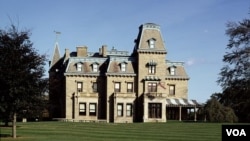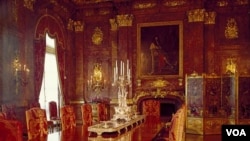In F. Scott Fitzgerald’s 1926 short story "The Rich Boy," a character famously remarked, “The rich are different from you and me.” To this day, Americans love to peek into the lives - and enclaves - of the very rich.
They include one of the greatest concentrations of magnificent homes in the world, on an island in America’s smallest state.
It’s Newport, Rhode Island, the nation’s first summer resort.
Newport was founded in 1639 by settlers seeking religious freedom and soon prospered as a seaport.
Gradually, wealthy landowners from the American South sought relief from the summertime heat and built grand homes there, on bluffs overlooking the Atlantic Ocean.
But these were mere huts compared with what was to come. In the 1880s and ’90s, wealthy industrialists began creating what they called “summer cottages” in Newport. Cottages on the scale of European castles.
Most famous was The Breakers, built by Cornelius Vanderbilt in the style of an Italian palace. And as a wedding present to his bride, Vanderbilt’s brother, William, erected an even more lavish home out of marble. Gold leaf, fine tapestries, and elaborate silver service adorned the modern palaces that were built all across town.
Each May, “the 400,” as Newport’s elite called each other, would arrive by yacht or private railroad car, bringing their servants with them.
But the advent of the income tax, the stock market crash of 1929, and the Great Depression that followed made it difficult for many of the multi-millionaires to maintain their “cottages” in the style to which they had become accustomed. Many lost interest in Newport and began to summer elsewhere around the world.
Some of the 200 or so grand mansions on Bellevue Avenue and Ocean Drive were converted into apartments. More than 40 burned down. But seven of the greatest homes, including The Breakers, landed in the hands of the local preservation society and today are open for public tours.
Combined with the city’s famous yacht races and jazz festival, the surviving great homes - rising like fortresses along the Newport cliffs - remain alluring for those who want to see just how differently from you and me the very rich can live.
They include one of the greatest concentrations of magnificent homes in the world, on an island in America’s smallest state.
It’s Newport, Rhode Island, the nation’s first summer resort.
Newport was founded in 1639 by settlers seeking religious freedom and soon prospered as a seaport.
Gradually, wealthy landowners from the American South sought relief from the summertime heat and built grand homes there, on bluffs overlooking the Atlantic Ocean.
But these were mere huts compared with what was to come. In the 1880s and ’90s, wealthy industrialists began creating what they called “summer cottages” in Newport. Cottages on the scale of European castles.
Most famous was The Breakers, built by Cornelius Vanderbilt in the style of an Italian palace. And as a wedding present to his bride, Vanderbilt’s brother, William, erected an even more lavish home out of marble. Gold leaf, fine tapestries, and elaborate silver service adorned the modern palaces that were built all across town.
Each May, “the 400,” as Newport’s elite called each other, would arrive by yacht or private railroad car, bringing their servants with them.
But the advent of the income tax, the stock market crash of 1929, and the Great Depression that followed made it difficult for many of the multi-millionaires to maintain their “cottages” in the style to which they had become accustomed. Many lost interest in Newport and began to summer elsewhere around the world.
Some of the 200 or so grand mansions on Bellevue Avenue and Ocean Drive were converted into apartments. More than 40 burned down. But seven of the greatest homes, including The Breakers, landed in the hands of the local preservation society and today are open for public tours.
Combined with the city’s famous yacht races and jazz festival, the surviving great homes - rising like fortresses along the Newport cliffs - remain alluring for those who want to see just how differently from you and me the very rich can live.








